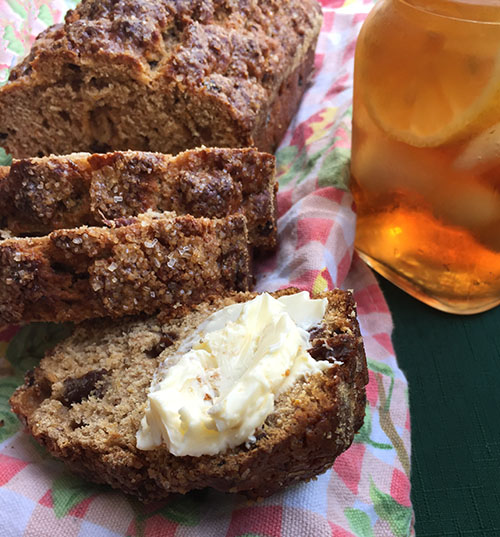 [G]reat discoveries can happen in your own backyard, or, in this case, your own bookshelf. I was recently cleaning (gasp!) and re-organizing some books, and I stumbled across a little baking book from Ireland, actually named “The Little Irish Baking Book,†by Ruth Isabel Ross (1995), and, eager to take a break from said cleaning, began thumbing through.
[G]reat discoveries can happen in your own backyard, or, in this case, your own bookshelf. I was recently cleaning (gasp!) and re-organizing some books, and I stumbled across a little baking book from Ireland, actually named “The Little Irish Baking Book,†by Ruth Isabel Ross (1995), and, eager to take a break from said cleaning, began thumbing through.
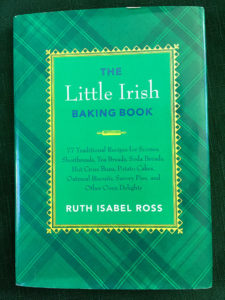 It had been on my bookshelf for awhile, and I had spent time with it before, but I suddenly found myself captivated by a number of the recipes, particularly an interesting-looking tea bread.
It had been on my bookshelf for awhile, and I had spent time with it before, but I suddenly found myself captivated by a number of the recipes, particularly an interesting-looking tea bread.
[B]y tea, I really mean tea. Fruit (raisins, sultanas, dates, etc.) is soaked in cold brewed tea as the flavor foundation for this bread. I had previously (10/15) made an Irish barmbrack (or “breac,†meaning “speckled breadâ€), where the fruit in the bread is plumped in hot black tea. This cold tea version — and the thought of all the cold tea I consume each summer — inspired me to try out a bread recipe that, flavored with tea, also seemed perfect to accompany iced tea on a warm afternoon.
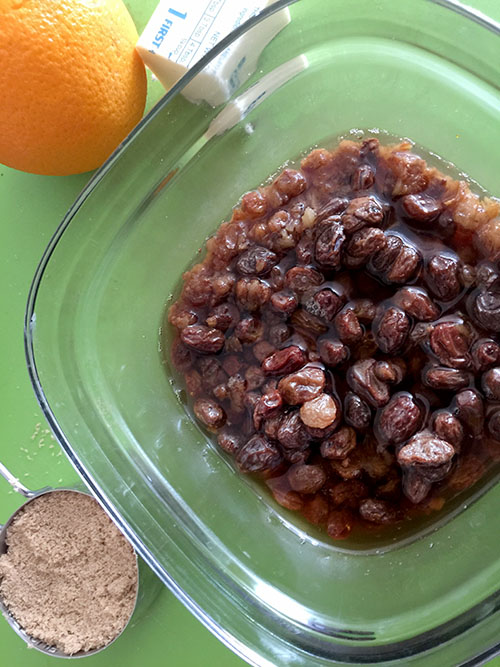 [I] soaked raisins and dates in one of my favorite black teas (Red Rose) all night in the fridge. Over low heat in a pot on the stove, the fruit and tea were combined with butter and brown sugar, until those dissolved (seemed an ingenious way of incorporating these ingredients), and orange zest and juice were then added.
[I] soaked raisins and dates in one of my favorite black teas (Red Rose) all night in the fridge. Over low heat in a pot on the stove, the fruit and tea were combined with butter and brown sugar, until those dissolved (seemed an ingenious way of incorporating these ingredients), and orange zest and juice were then added.
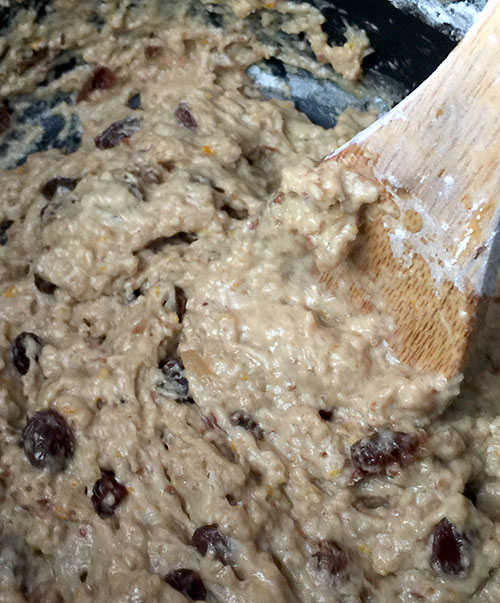 [A]fter this mixture cooled, an egg and two cups of self rising flour (easy-to-make: for every one cup flour, mix in 1-1/4 teaspoons baking powder and 1/4 teaspoon salt) and a heaping (1-1/4) teaspoon of cinnamon. What a simple, but effective combination of flavors! I also added a wee bit of vanilla.
[A]fter this mixture cooled, an egg and two cups of self rising flour (easy-to-make: for every one cup flour, mix in 1-1/4 teaspoons baking powder and 1/4 teaspoon salt) and a heaping (1-1/4) teaspoon of cinnamon. What a simple, but effective combination of flavors! I also added a wee bit of vanilla.
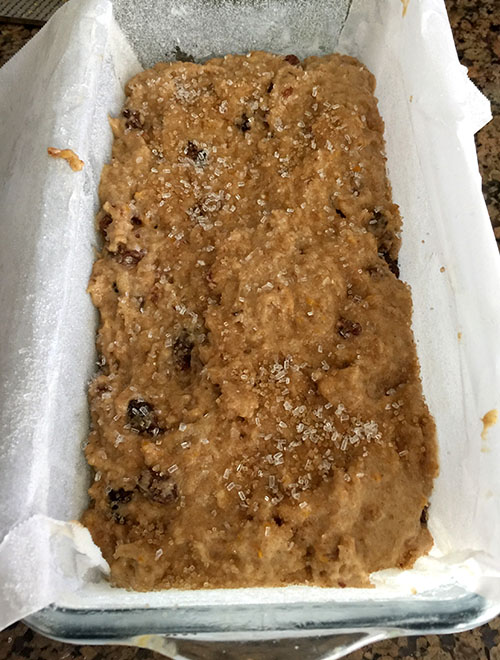 [T]his yields a stiffer batter than most quick breads; it felt a little more like the early stages of a yeast dough, lovely and richly tan from the tea and cinnamon. I spread the dough in a buttered and sugared (rather than sprinkling with flour) parchment-lined 8-inch loaf pan. I also sprinkled a combo of turbinado and sparkling sugar across the top.
[T]his yields a stiffer batter than most quick breads; it felt a little more like the early stages of a yeast dough, lovely and richly tan from the tea and cinnamon. I spread the dough in a buttered and sugared (rather than sprinkling with flour) parchment-lined 8-inch loaf pan. I also sprinkled a combo of turbinado and sparkling sugar across the top.
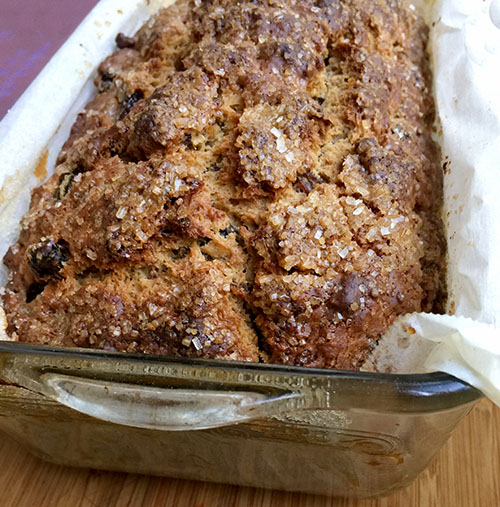 [T]hough the recipe directions said to bake the loaf at 350 degrees, I found mine was fully ready (I tested with a toothpick) after about an hour (so always check your oven…things do differ). This beautiful dark bronze loaf, crusty and sparkling, made the house smell heavenly. “Procrastibaking†be damned…to me, this type of aromatherapy was always a good excuse to fire up the oven!!!
[T]hough the recipe directions said to bake the loaf at 350 degrees, I found mine was fully ready (I tested with a toothpick) after about an hour (so always check your oven…things do differ). This beautiful dark bronze loaf, crusty and sparkling, made the house smell heavenly. “Procrastibaking†be damned…to me, this type of aromatherapy was always a good excuse to fire up the oven!!!
 [I] sliced easily through this sturdy bread’s sweet, craggy surface. Firm, yet tender, the buttered slice I tasted reminded me of the best soda bread — not too sweet with that little salty hint, lighter than you would expect, and here, an undercurrent of black tea infusing the bread and bolstering the juiciness of the earthy dried fruit (as well as providing a little caffeine boost).
[I] sliced easily through this sturdy bread’s sweet, craggy surface. Firm, yet tender, the buttered slice I tasted reminded me of the best soda bread — not too sweet with that little salty hint, lighter than you would expect, and here, an undercurrent of black tea infusing the bread and bolstering the juiciness of the earthy dried fruit (as well as providing a little caffeine boost).
What more undiscovered treasures lie between the pages of little books?
Fruit and Orange Bread
From “The Little Irish Baking Book†By Ruth Isabel Ross (1995)
Makes 1 loaf
1-1/4 cups fruit (candied peel, sultanas or raisins, chopped dates)
2/3 cup cold tea
2/3 cup brown sugar
1/2 stick butter
Grated rind of 1 orange
2 tablespoons freshly squeezed orange juice
1 egg, beaten
2 cups white self-rising flour
1-1/4 teaspoon cinnamon
Soak fruit in the cold tea overnight.
Heat the fruit mixture and add the sugar and butter, stirring until they dissolve. Add the orange rind and juice. Cool. Add the egg. Add the flour and cinnamon.
Pour the mixture in a 1 lb. greased and lined loaf tin and bake at 350 degrees for 1 hour and 20 minutes.
Blogger’s Note: Please do begin checking your bread (toothpick or skewer test) at one hour. Also, I used just 1/3 cup brown sugar in this recipe, as well as adding 1/2 teaspoon vanilla to the batter, and sprinkled raw sugar on top.